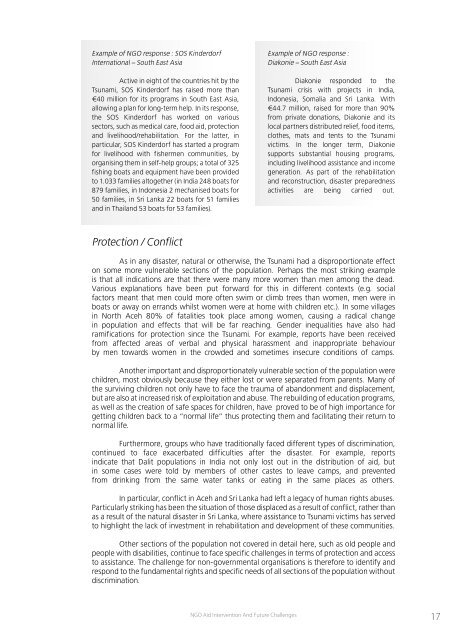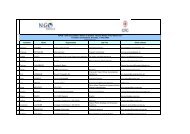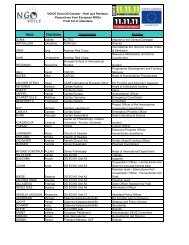Tsunami one year after, NGO aid intervention and future ... - VOICE
Tsunami one year after, NGO aid intervention and future ... - VOICE
Tsunami one year after, NGO aid intervention and future ... - VOICE
Create successful ePaper yourself
Turn your PDF publications into a flip-book with our unique Google optimized e-Paper software.
Example of <strong>NGO</strong> response : SOS Kinderdorf<br />
International – South East Asia<br />
Active in eight of the countries hit by the<br />
<strong>Tsunami</strong>, SOS Kinderdorf has raised more than<br />
€40 million for its programs in South East Asia,<br />
allowing a plan for long-term help. In its response,<br />
the SOS Kinderdorf has worked on various<br />
sectors, such as medical care, food <strong>aid</strong>, protection<br />
<strong>and</strong> livelihood/rehabilitation. For the latter, in<br />
particular, SOS Kinderdorf has started a program<br />
for livelihood with fishermen communities, by<br />
organising them in self-help groups; a total of 325<br />
fishing boats <strong>and</strong> equipment have been provided<br />
to 1.033 families altogether (in India 248 boats for<br />
879 families, in Ind<strong>one</strong>sia 2 mechanised boats for<br />
50 families, in Sri Lanka 22 boats for 51 families<br />
<strong>and</strong> in Thail<strong>and</strong> 53 boats for 53 families).<br />
Example of <strong>NGO</strong> response :<br />
Diakonie – South East Asia<br />
Diakonie responded to the<br />
<strong>Tsunami</strong> crisis with projects in India,<br />
Ind<strong>one</strong>sia, Somalia <strong>and</strong> Sri Lanka. With<br />
€44.7 million, raised for more than 90%<br />
from private donations, Diakonie <strong>and</strong> its<br />
local partners distributed relief, food items,<br />
clothes, mats <strong>and</strong> tents to the <strong>Tsunami</strong><br />
victims. In the longer term, Diakonie<br />
supports substantial housing programs,<br />
including livelihood assistance <strong>and</strong> income<br />
generation. As part of the rehabilitation<br />
<strong>and</strong> reconstruction, disaster preparedness<br />
activities are being carried out.<br />
Protection / Conflict<br />
As in any disaster, natural or otherwise, the <strong>Tsunami</strong> had a disproportionate effect<br />
on some more vulnerable sections of the population. Perhaps the most striking example<br />
is that all indications are that there were many more women than men among the dead.<br />
Various explanations have been put forward for this in different contexts (e.g. social<br />
factors meant that men could more often swim or climb trees than women, men were in<br />
boats or away on err<strong>and</strong>s whilst women were at home with children etc.). In some villages<br />
in North Aceh 80% of fatalities took place among women, causing a radical change<br />
in population <strong>and</strong> effects that will be far reaching. Gender inequalities have also had<br />
ramifications for protection since the <strong>Tsunami</strong>. For example, reports have been received<br />
from affected areas of verbal <strong>and</strong> physical harassment <strong>and</strong> inappropriate behaviour<br />
by men towards women in the crowded <strong>and</strong> sometimes insecure conditions of camps.<br />
Another important <strong>and</strong> disproportionately vulnerable section of the population were<br />
children, most obviously because they either lost or were separated from parents. Many of<br />
the surviving children not only have to face the trauma of ab<strong>and</strong>onment <strong>and</strong> displacement,<br />
but are also at increased risk of exploitation <strong>and</strong> abuse. The rebuilding of education programs,<br />
as well as the creation of safe spaces for children, have proved to be of high importance for<br />
getting children back to a “normal life” thus protecting them <strong>and</strong> facilitating their return to<br />
normal life.<br />
Furthermore, groups who have traditionally faced different types of discrimination,<br />
continued to face exacerbated difficulties <strong>after</strong> the disaster. For example, reports<br />
indicate that Dalit populations in India not only lost out in the distribution of <strong>aid</strong>, but<br />
in some cases were told by members of other castes to leave camps, <strong>and</strong> prevented<br />
from drinking from the same water tanks or eating in the same places as others.<br />
In particular, conflict in Aceh <strong>and</strong> Sri Lanka had left a legacy of human rights abuses.<br />
Particularly striking has been the situation of those displaced as a result of conflict, rather than<br />
as a result of the natural disaster in Sri Lanka, where assistance to <strong>Tsunami</strong> victims has served<br />
to highlight the lack of investment in rehabilitation <strong>and</strong> development of these communities.<br />
Other sections of the population not covered in detail here, such as old people <strong>and</strong><br />
people with disabilities, continue to face specific challenges in terms of protection <strong>and</strong> access<br />
to assistance. The challenge for non-governmental organisations is therefore to identify <strong>and</strong><br />
respond to the fundamental rights <strong>and</strong> specific needs of all sections of the population without<br />
discrimination.<br />
<strong>NGO</strong> Aid Intervention And Future Challenges<br />
17






